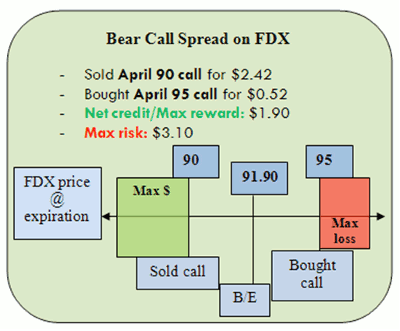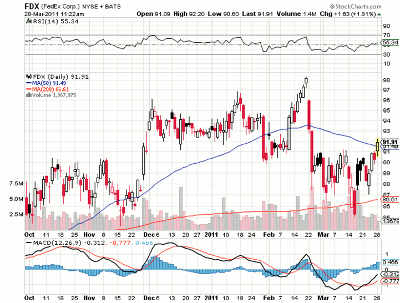With bearish forces impacting shares of the shipping giant, see how one trader executed a bear call spread that would profit from a decline while still incorporating an “insurance policy” against an upside move.
Late last week, FedEx Corporation (FDX) CFO Alan Graf took the podium at a JPMorgan conference in New York, telling attendees that Dutch postal group TNT NV's (TNTTY) express business was "too expensive" to acquire.
Furthermore, the executive said the delivery diva has its "own organic plans" for growth in certain European countries, meaning there's currently no need to make acquisitions across the pond. In addition, Graf said the company's operations in China are "growing very rapidly" and expressed optimism about the business turning profitable in fiscal 2012.
While we can't be sure of the catalyst, the shares of FDX defied the broad-market trend higher that day, giving up 0.4%. However, the stock has popped higher this week. What's more, taking a look at the action in the options pits suggests at least one trader is employing calls to bet on more downside for the stock in the short term, but has implemented "insurance" to guard against a rebound.
On Friday, several hundred April 90 calls changed hands at the bid price of $2.42, implying they were likely sold. At the same time, a symmetrical block of April 95 calls traded for the ask price of $0.52 apiece, suggesting they were bought. As such, it seems we may have uncovered a bear call spread on FDX.
Had the trader simply sold the 90-strike calls, he could pocket the entire $2.42 credit as long as FDX finished south of the $90 level when April-dated options expire. However, call writing can be risky, and the investor's losses would accumulate the further FDX should rally north of the $92.42 level (strike plus credit) within the options' lifetime. By handcuffing the sold 90-strike calls with the bought out-of-the-money calls, the speculator has limited his risk in the event of a significant move against him.
More specifically, the trader can still retain the net credit of $1.90 (premium received from the 90-strike calls minus premium paid for the 95-strike calls) as long as FDX ends south of $90 at expiration. In fact, the trader has even lowered his breakeven to $91.90 (sold call strike plus net credit). Plus, his maximum risk is capped at $3.10 per pair of calls (difference between strikes minus net credit), no matter how high the security should climb.
At last check, FDX broke above the 50-day moving average by early afternoon on Monday:
By Andrea Kramer, contributor, Schaeffer’s Trading Floor Blog




















